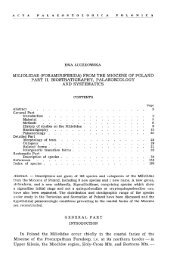The skull of Velociraptor - Acta Palaeontologica Polonica
The skull of Velociraptor - Acta Palaeontologica Polonica
The skull of Velociraptor - Acta Palaeontologica Polonica
You also want an ePaper? Increase the reach of your titles
YUMPU automatically turns print PDFs into web optimized ePapers that Google loves.
ACTA PALAEONTOLOGICA POLONICA (44) (2) 193<br />
both laterally and caudally. In dorsal view, the <strong>skull</strong> has a striking appearance, due to the narrow-<br />
ness <strong>of</strong> the snout, the width <strong>of</strong> which equals only about a third <strong>of</strong> the postorbital <strong>skull</strong> width. <strong>The</strong><br />
snout is also long in comparison to the short frontoparietal part <strong>of</strong> the <strong>skull</strong> ro<strong>of</strong> between the<br />
supratemporal fenestra (Figs 2B, 3B, 4B). <strong>The</strong> lateral apices <strong>of</strong> the lacrimals extend somewhat be-<br />
yond the jugals. <strong>The</strong> supratemporal arcades are laterally convex making the supratemporal fossae<br />
(and fenestrae) almost circular. <strong>The</strong> <strong>skull</strong> is about twice as wide across the temporal arcades as be-<br />
tween the orbits. <strong>The</strong> supraorbital fossae are bounded caudally by a steep, sharp nuchal crest. <strong>The</strong><br />
nuchal crest is confluent medially with the sagittal crest, which is relatively low and short, and ex-<br />
tends along the open sutural interparietal contact.<br />
Table 1. Skull and mandible measurements (in mrn) <strong>of</strong> <strong>Velociraptor</strong> mongoliensis (GIN 100125)<br />
Maximum length <strong>of</strong> <strong>skull</strong> (paroccipital process-tip <strong>of</strong> snout)<br />
230<br />
Medial length <strong>of</strong> <strong>skull</strong> (transverse nuchal crest-tip <strong>of</strong> snout) 2 13<br />
Width across supratemporal arcades 1 77 1<br />
Width across occiput 1 69 1<br />
Width across lateral tips <strong>of</strong> lacrimals 1 Xi 1<br />
Width across parietals (at about midlength)<br />
Maximum depth<br />
27<br />
66<br />
Length <strong>of</strong> snout (rostra1 margin <strong>of</strong> orbit-tip) 1 140 1<br />
Width <strong>of</strong> snout (in front <strong>of</strong> rostra1 ends <strong>of</strong> lacrimals)<br />
Depth <strong>of</strong> snout (in front <strong>of</strong> orbit)<br />
Length <strong>of</strong> mandible<br />
Maximum depth <strong>of</strong> mandible (behind external fenestra)<br />
22<br />
45<br />
210<br />
23<br />
<strong>The</strong> distinctive appearance <strong>of</strong> the <strong>skull</strong> in <strong>Velociraptor</strong>, with its short temporal re-<br />
gion, rounded temporal fenestrae and very long, narrow snout has not been noticed so<br />
far. <strong>The</strong> <strong>skull</strong> proportions, with the length <strong>of</strong> the preorbital region exceeding almost 4.5<br />
times the length <strong>of</strong> the postorbital region, distinguish <strong>Velociraptor</strong> from Dromaeo-<br />
saurus and Deinonychus, in which the preorbitallengths are about 2.5-3.5 times these<br />
<strong>of</strong> the postorbital regions. Among theropods, such a long snout occurs only in the<br />
ornithomimids. <strong>The</strong> subcircular shape <strong>of</strong> the temporal fenestra is the character that dis-<br />
tinctly differs <strong>Velociraptor</strong> from Deinonychus. <strong>The</strong> right temporal arcade is complete<br />
in YPM 5210 specimen <strong>of</strong> D. antirrhopus and it seems subparallel to the medial line <strong>of</strong><br />
the <strong>skull</strong>. As a result, the supratemporal fenestra is elongate and relatively narrow in<br />
Deinonychus, and its width (measured across its caudal portion) constitutes about 30%<br />
<strong>of</strong> the length <strong>of</strong> the fenestra. <strong>The</strong> temporal arcade is laterally convex in <strong>Velociraptor</strong>,<br />
and the width <strong>of</strong> the fenestra is more than 50% <strong>of</strong> its length. Due to the shape <strong>of</strong> the<br />
supratemporal arcade, the supratemporal fenestra is wider in <strong>Velociraptor</strong>, and it pro-<br />
vided more space for the adductor muscles than the fenestra in Deinonychus. At the<br />
same time, the sagittal extent <strong>of</strong> the adductor origins was relatively greater in the<br />
American than in the Mongolian genus. It might result in a more oblique direction <strong>of</strong><br />
some adductor fibres in Deinonychus. <strong>The</strong> unique specimen <strong>of</strong> Dromaeosaurus en-<br />
tirely lacks the temporal arcade, as well as most <strong>of</strong> the parietal; thus the shape <strong>of</strong> the

















